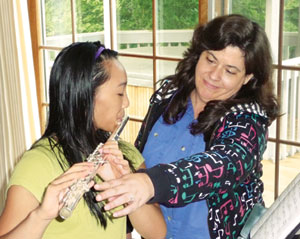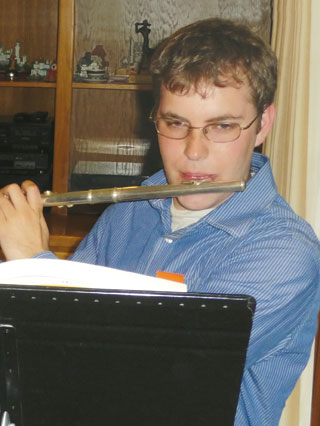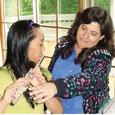 Teaching is a rewarding and challenging profession, whether it is a full-time career or a part-time source of additional income. It can be exhilarating, fulfilling, and intellectually stimulating, while being simultaneously frustrating and tedious, particularly when you are reminding a student to play B natural instead of B flat for the umpteenth time.
Teaching is a rewarding and challenging profession, whether it is a full-time career or a part-time source of additional income. It can be exhilarating, fulfilling, and intellectually stimulating, while being simultaneously frustrating and tedious, particularly when you are reminding a student to play B natural instead of B flat for the umpteenth time.
Before accepting students, consider the following qualities and ask whether you fit the mold:
• Good teachers have positive attitudes and dispositions.
• Their flute skills and knowledge of the subject matter is strong.
• They possess good communication skills and have the ability to explain concepts well.
• Good teachers are patient.
If you think you qualify, consider starting off on a small scale with one or two young students to see if you enjoy teaching.
One of the things that I like most about teaching is the wide variety of students in my studio. Currently, my students range in age from 9 to 70 in all skill levels. Some are quiet and shy, while others have boisterous personalities. There is great satisfaction in watching their skills and love of music develop.
Flexibility is Key
Effective teachers tailor the curriculum to the needs of individual students, who learn at different rates and often have a variety of learning styles. Tactile or kinesthetic learners respond best to activities they can feel; visual learners find it beneficial to observe; auditory learners learn by listening. Teachers should be prepared to diverge from a planned curriculum when students ask questions about topics outside of the day’s lesson. The perfect time to teach is when students become interested in something.
Many years ago I had a 7-year-old student named Michael. At his first flute lesson, he asked about the mechanics of the flute, particularly the linkages between the keys. Rather than spending the lesson working only on tone production, I spent the first 10 minutes satisfying his mechanical curiosity by showing him three different ways to finger B flat. With his questions answered he was then able to focus on headjoint work and sound production.
One Size Doesn’t Fit All
Students should be challenged but not overwhelmed with material that is too difficult. Change strategies and materials when students don’t progress as expected. I try to be flexible and creative and find fresh approaches for those who are floundering.
Variations in hand size and finger and arm length make it impossible to have a one-size-fits-all hand position for all students; we should adapt students’ hand and body positions and embouchures based on their physical characteristics. Likewise, variations in face shape and the size and shape of the lips make a uniform embouchure impractical. Some students also blow naturally in the center of the lips, while others blow slightly off-center.
Facial muscle strain can occur inadvertently when teachers insist that all students blow from the center of the lips. As flute pedagogue Patricia George states, “Students should play the flute with their natural face,” rather than in a standardized position. More than one approach to articulation, vibrato, and other basic skills is necessary.
When she began private lessons, 16-year-old Sarah was struggling with a weak tone, and improving this became a priority. We worked on Suzuki tonguing (spitting rice) and developing a strong air stream, which greatly improved her tone for a while. Then, her sound became inconsistent, sometimes lovely, but other times weak, even with frequent reminders to use more air.
Her lip position sometimes shifted laterally on the embouchure plate, which caused most of the air stream to miss the tone hole completely. Students with an off-center embouchure should center the flute’s tone hole under the air stream, not under the lips, and they should tongue in the center of the embouchure.
Once the problem was diagnosed, I asked Sarah to practice in front of a mirror, so she could position the tone hole under the air stream consistently and monitor that the tongue was in the center of the embouchure.
Strengths and Weaknesses
With new students I make a numbered list of their strengths and weaknesses, looking at basics, such as hand and body position, tonguing, tone, note and rhythmic accuracy. I then chart a course of study for each student. I choose a maximum of three skills from the weak list to concentrate on during the initial lessons. As these skills improve, I introduce curriculum to improve other skills further down the list.
Be Positive
While working on problems, remember to offer compliments on things done well so students feel successful. Positive reinforcement is an effective tool. I try to remember that I am teaching students and not the flute and sandwich a correction between two compliments: “You did a great job playing the notes and rhythms in that phrase. Now, let’s go back and work on the articulations.” After the repetition: “This time the articulations were much more accurate.”
Creative Ideas
Some of my most effective teaching ideas coincide with holidays or other special events. For instance, in a band sectional last Halloween, I taught a group of beginners the first few measures of “The Addam’s Family Theme” to reinforce the F major scale. At the end of the sectional, they performed for the rest of the band, who happily provided accompanying finger snaps between the phrases. The entire band was able to share a fun activity, and the flutists learned a new scale.
Despite our best efforts, students sometimes have difficulty grasping new ideas. This is when I switch to a different teaching style. For example, when teaching rhythm to auditory learners, I explain the concept verbally and then demonstrate the rhythm audibly. I show visual learners the rhythm pattern on the page and ask them to watch me tap or clap the rhythmic pattern. Tactile learners learn best by feeling the rhythm, either tapping it along with the teacher or feeling the teacher gently tapping the rhythm on their shoulder.
You can also develop a new exercise for the rhythm. Dotted eighths and sixteenths remained difficult for one of my students, even after multiple explanations. To clarify the rhythm, I used mac-a-ron-i as a rhythm word for four 16ths. Then we used the first and last syllables of mac-a-ron-i (mac- – -i )for the dotted-eighth-sixteenth rhythm.
Set the Stage
Ideally, students should look forward to their lessons. A friendly, welcoming environment helps encourage this. Express an interest in their activities, and ask how their day or week has gone. Sometimes they arrive with wonderful or troubling news that may hinder concentration unless they get the opportunity to share it. Expressing an interest in opens the door to further communication and provides an effective segue into the lesson.
 Be a Good Listener
Be a Good Listener
When students stumble repeatedly within a particular passage, ask them what they think the problem is. Listen carefully to the answer to find clues for a solution. Watch for comments or body language that indicate frustration, and adjust the lesson accordingly. On the other end of the spectrum, inquisitive students might ask in-depth questions about previously studied issues or new concepts. These questions show a readiness to learn. Be flexible enough to alter the lesson to explore these questions.
Continuing Education
There is always something more to learn about teaching. Over the years, my students have taught me a lot about thinking analytically and breaking concepts into step-by-step lessons. I have also learned from colleagues, who have been willing to share teaching techniques. This has raised the standard of teaching for all of us. Masterclasses, workshops, flute magazines, books, concerts, and recordings are also ways to enrich individual teaching skills and stay abreast of what is new in the field.
Starting a Studio
The logistics of actually starting a studio may be mundane, but to begin you need students. There are several ways to this. If you plan to teach outside of your home, contact local music stores and music schools to inquire about availability and terms for use of studio space. Some places rent space at a daily or hourly rate while others charge a fee per student. All generally provide referrals to help you build your studio, and some may even provide billing services.
Advertising the new studio is also important, and one of the best ways to do it is through referrals from other teachers. Introduce yourself to local flute teachers, detail your qualifications, and offer to take any overflow from their studios. The local flute club, public school band directors, and music stores often keep lists of private flute instructors. Ask to be included on them. You can even offer to work with flute sections in nearby schools or give a free flute workshop. This will earn goodwill from band directors and may produce referrals. It also provides an opportunity to distribute information, such as a flyer or your business card, to potential students.
Remember that enjoying what you do is perhaps the most important teaching tool you can have. Teachers who enjoy what they do usually have satisfied students who enjoy flute lessons.






